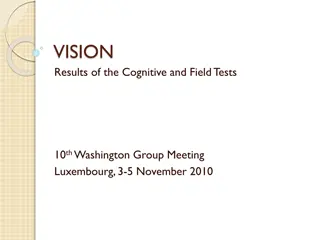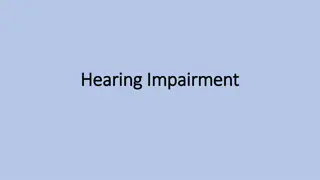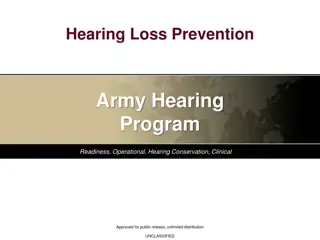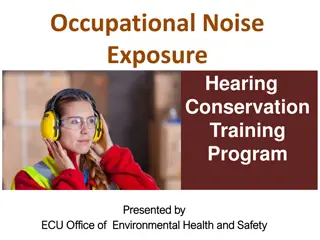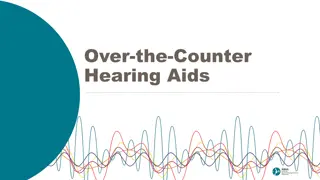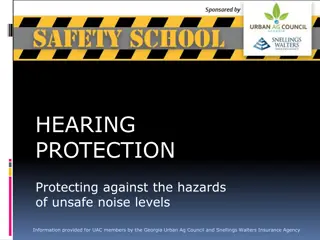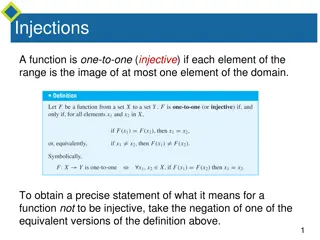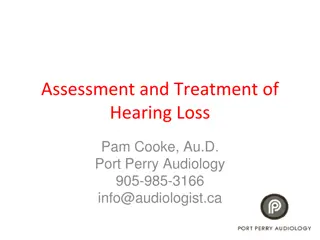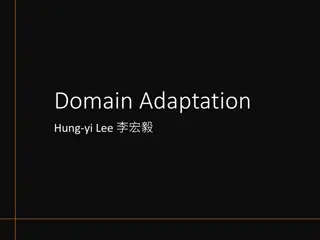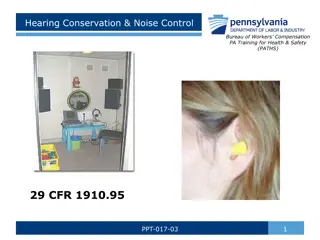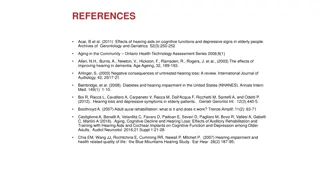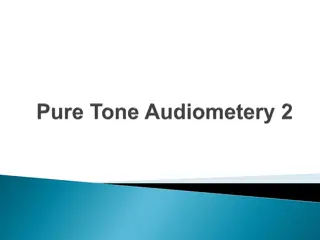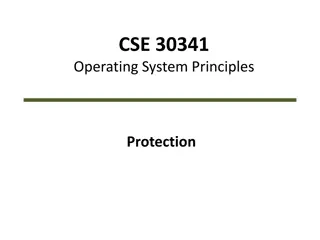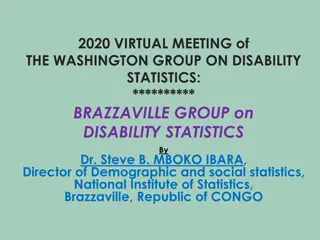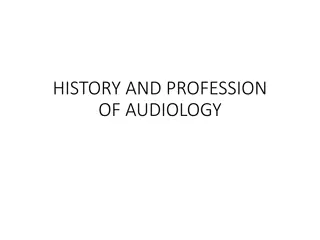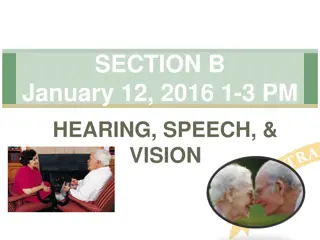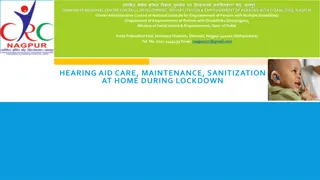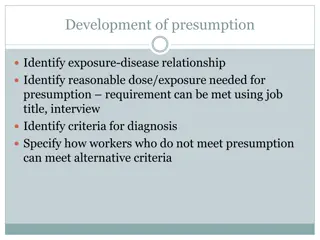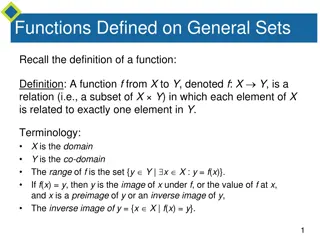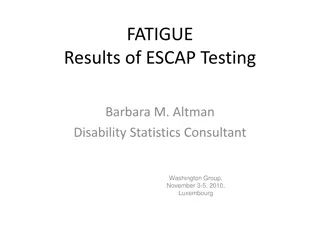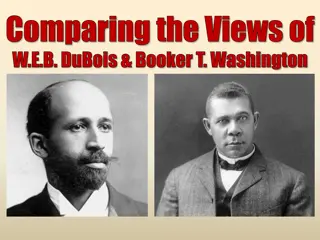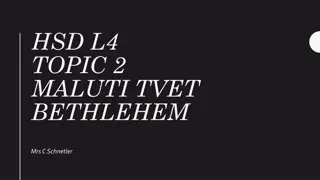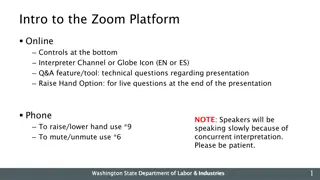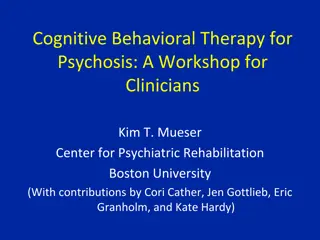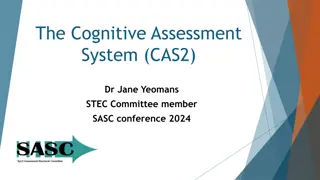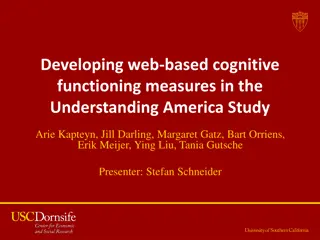Insights from Cognitive and Field Testing on Hearing Domain at the 10th Washington Group Meeting
Delving into the comprehensive assessment of the hearing domain, this document highlights the various aspects of hearing including perception, challenges, aids, and impact on daily activities. It showcases the findings and conclusions drawn from cognitive testing, focusing on questions on difficulty in hearing, use of hearing aids, and hearing in different environments. Additionally, the field testing excerpts explore a wider scope of questions related to hearing challenges, aid usage, limitations, and onset of difficulty. The insights gathered provide valuable information for understanding and addressing hearing impairments effectively.
Download Presentation

Please find below an Image/Link to download the presentation.
The content on the website is provided AS IS for your information and personal use only. It may not be sold, licensed, or shared on other websites without obtaining consent from the author. Download presentation by click this link. If you encounter any issues during the download, it is possible that the publisher has removed the file from their server.
E N D
Presentation Transcript
HEARING DOMAIN 10th Washington Group meeting Luxembourg 3-5 November 2010 B.Tserenkhand National Statistical Office of Mongolia
HEARING Hearing is a sense that includes a number of specific functions perception of loudness, pitch, discrimination of speech signals, and localization of sounds. Hearing is not a simple sensory function and a hearing loss is not easily rectified by the use of a hearing aid. Hearing is a body function classified under ICF
COGNITIVE TESTING Questions tested Difficulty hearing with use of hearing aid Use of a hearing aid Hearing in noise Hearing in quiet
COGNITIVE TESTING Conclusions from cognitive test results The first question was kept unchanged as it forms part of the WG Short Set of questions. The questions on use and frequency of use of a hearing aid were left unchanged. The two questions on hearing in noise and in quiet were reversed starting with hearing in a quiet room .
FIELD TESTING Field test questions HEAR_SS Do you have difficulty hearing, even when using a hearing aid?- no difficulty, some difficulty, a lot of difficulty, cannot do at all HEAR_1 Do you use a hearing aid? yes, no, refused, don t know HEAR_2 How often do you use your hearing aid(s)? - all of the time, some of the time, rarely, never, refused, don t know
FIELD TESTING Field test questions HEAR_3 Do you have difficulty hearing what is said in a conversation with one other person in a quiet room [even when wearing your hearing aid(s)]?- no difficulty, some difficulty, a lot of difficulty, cannot do at all HEAR_4 Do you have difficulty hearing what is said in a conversation with one other person in a noisier room [even when wearing your hearing aid(s)]? - no difficulty, some difficulty, a lot of difficulty, cannot do at all
FIELD TESTING Field test questions HEAR_5 How old were you when the difficulty hearing began?- age in years, refused, don t know HEAR_6 How much does your difficulty hearing limit your ability to carry out daily activities? - not at all, a little, a lot, completely, refused, don t know
FIELD TESTING Field test results HEAR_SS Across pilot test countries 90 percent of respondents reported no difficulty in hearing, Cambodia and Kazakhstan showed the lowest rate of no difficulty 87 percent. Very few respondents use a hearing aid 35 in total across all countries. Only 7 respondents reported using their hearing aid all the time, and 13 using it some of the time. A further 8 respondents rarely or never used their hearing aid.
FIELD TESTING Hear in quiet by HEAR_SS Hear in quiet room (HEAR_3) some diff 5543 94 272 246 a lot of diff 5 11 cannot do at all 16 0 no diff Total 5658 530 HEAR_SS no diff some diff a lot of diff 17 30 43 0 90 Total 5833 373 59 16 6283 More people have difficulty on HEAR_SS than in quiet (289 missed by quiet Q) 115 missed on HEAR_SS: hearing aid clause? 21 respondents with no diff on HEAR_SS but a lot of diff and cannot do on hear in quiet.
FIELD TESTING Hear in noise by HEAR_SS Hear in noisier room (HEAR_4) some diff 5255 341 64 357 a lot of diff 40 99 cannot do at all 5 9 no diff Total 5648 529 HEAR_SS no diff some diff a lot of diff 1 14 62 13 90 Total 5321 714 203 27 6272 Hear in noise picks up more people (386 people missed by HEAR_SS) 65 people missed on hearing in noise that are picked up by HEAR_SS (? other aspects of hearing e.g. tinnitus)
FIELD TESTING Impact of age on hearing difficulties 120% 100% 80% 60% 40% no diff 20% some diff 0% 80+ yrs 80+ yrs 80+ yrs 0-16 yrs 0-16 yrs 0-16 yrs a lot of diff 17-59 yrs 60-79 yrs 17-59 yrs 60-79 yrs 17-59 yrs 60-79 yrs Age categorised Age categorised Age categorised HEAR_SS hear quiet hear noise
FIELD TESTING Impact of hearing difficulty on daily activities Impact on daily activities Total HEAR_SS not at all 229 214 18 2 a little 151 278 27 2 a lot 10 31 41 6 completely 1 4 3 4 no diff some diff a lot of diff cannot do at all 391 527 89 14 Total 463 460 90 12 1025 No and some difficulty on SS = no impact A lot of diff --> no impact = ? Effect of noise (false positives?) 162 have an impact but no diff on HEAR_SS Impact of other domain difficulties? Cannot do + a little impact = Deaf people?
PILOT TESTING Main findings for Hearing Intent of questions are understood hearing in noise is more difficult activity than hearing in quiet HEAR_SS is somewhere in between Some but relatively small confusion with hearing aid clause No major differences between countries of the pilot testing
PILOT TESTING Recommendation Retain the three questions, but possibly change the order where the question about using a hearing aid is asked as the first question The revised extended set of questions for hearing include two options
PILOT TESTING Proposed extended set for hearing: Option 1 HEAR_1 Do you use a hearing aid? (If yes, use h/aid clause in subsequent questions) HEAR_2 How often do you use your hearing aid(s)? HEAR_SS Do you have difficulty hearing [even when wearing your hearing aid]?
PILOT TESTING Proposed extended set for hearing: Option 1 HEAR_3 Do you have difficulty hearing what is said in a conversation with one other person in a quiet room [even when wearing your hearing aid(s)]? HEAR_4 Do you have difficulty hearing what is said in a conversation with one other person in a noisier room [even when wearing your hearing aid(s)]?
PILOT TESTING Proposed extended set for hearing: Option 2 HEAR_1 Do you use a hearing aid? (If yes, use h/aid clause in HEAR_SS) HEAR_2 How often do you use your hearing aid(s)? HEAR_SS Do you have difficulty hearing [even when wearing your hearing aid]?
THANK YOU FOR YOUR ATTENTION www.nso.mn


